AMD Raven Ridge 8GB vs. 16GB Reserved Memory Benchmark & Explanation
We recently took our first look at AMD's Raven Ridge desktop APUs after a grueling four day grind of benchmarking the Ryzen 5 2400G and 关键字3Ryzen 3 2200G. Although both chips were impressive on that initial run, there's still loads of information that we'd like to cover, including deeper overclocking tests.
However, since posting the review, a few questions have popped up and the one that I've probably seen the most revolves around the Vega GPU's memory allocation.
Unlike a typical discrete graphics card, most integrated solutions don't have their own dedicated memory. For example, a Vega 64 has 8GB of dedicated memory where it can store data and then access it quickly when it needs to. Because this is a high-end graphics card, not only it has a large 8GB buffer but the bus it uses to access this memory is also quite fast. HBM2 provides a 2048-bit wide bus that with the memory clocked at 1.25GHz allows for a bandwidth of 483GB/s.

Further down the food chain, like at the bottom, you'll find graphics cards such as the RX 550. Because the compute performance for this card is around nine times lower, it doesn't require such a massive bandwidth or an 8GB memory buffer either. In fact, the RX 550 could only take advantage of half that capacity and in today's games the card works as well with a 2GB buffer. Regardless of capacity though, it uses memory clocked at 1.75GHz and with a 128-bit wide bus can be fed data at 112GB/s.
Shifting data in and out of system memory is significantly slower than VRAM.
So a typical RX 550 has a 2GB memory buffer that can shift data at a peak rate of 112GB/s. Now if a game requires 3GB of VRAM but you only have 2GB, some game assets spill over into system memory (RAM). I covered this in a bit more detail somewhat recently that investigated how much RAM gamers need.
Shifting data in and out of system memory is significantly slower than VRAM. The Raven Ridge APUs for example are limited to a memory bandwidth of around 35GB/s for system memory when using DDR4-3200. So in the case of the RX 550, it has a bandwidth of 112GB/s when accessing data locally using the VRAM, but when accessing data from system memory it's limited to 16GB/s (PCIe 3.0 x16 limit), which is to say that it takes at least seven times longer to process the same data.
If your computer runs out of system memory, game assets are then moved to the local storage device – meaning your hard drive, or hopefully SSD – and depending on how fast that device is and how heavily it's hit with data, you are very likely to see a noticeable dip in framerate at this point as the bandwidth would be reduced to around 500MB/s with a SATA SSD.
Keeping all that information in mind, note again that the integrated graphics chip inside the Raven Ridge APU has no local memory. We're stressing this because some integrated GPUs like the Vega M graphics in upcoming Intel Kaby Lake-G processors do have their own dedicated memory and this greatly enhances performance, but it's also much more costly.
Since AMD's Raven Ridge APUs are budget solutions, it wasn't practical to include HBM2 memory. So with no dedicated VRAM, it relies exclusively on system memory that is restricted to bandwidth of around 35GB/s when using DDR4-3200.
Of course, bandwidth is just part of the issue here, memory capacity also plays a key role. A system with a base model Radeon RX 550 and 8GB of DDR4 memory effectively has 10 GB of total memory. But when using the integrated Vega 8 or 11 graphics inside the Raven Ridge APUs, you have 8GB of memory that needs to be shared between the CPU and GPU.
Generally, Windows does a good job of managing memory and prioritizing applications for best results, but at least some portion of your system memory will be allocated to the integrated graphics. Raven Ridge APUs use a method called Unified Memory Architecture or UMA for short.
Most current AM4 motherboards let you set the memory size somewhere between 64MB and 2GB. Depending on what size you select, this will determine the maximum amount of system memory that is allocated exclusively to the Vega graphics. Once allocated, it can only be used as graphics memory and will no longer be accessible to the operating system or applications.
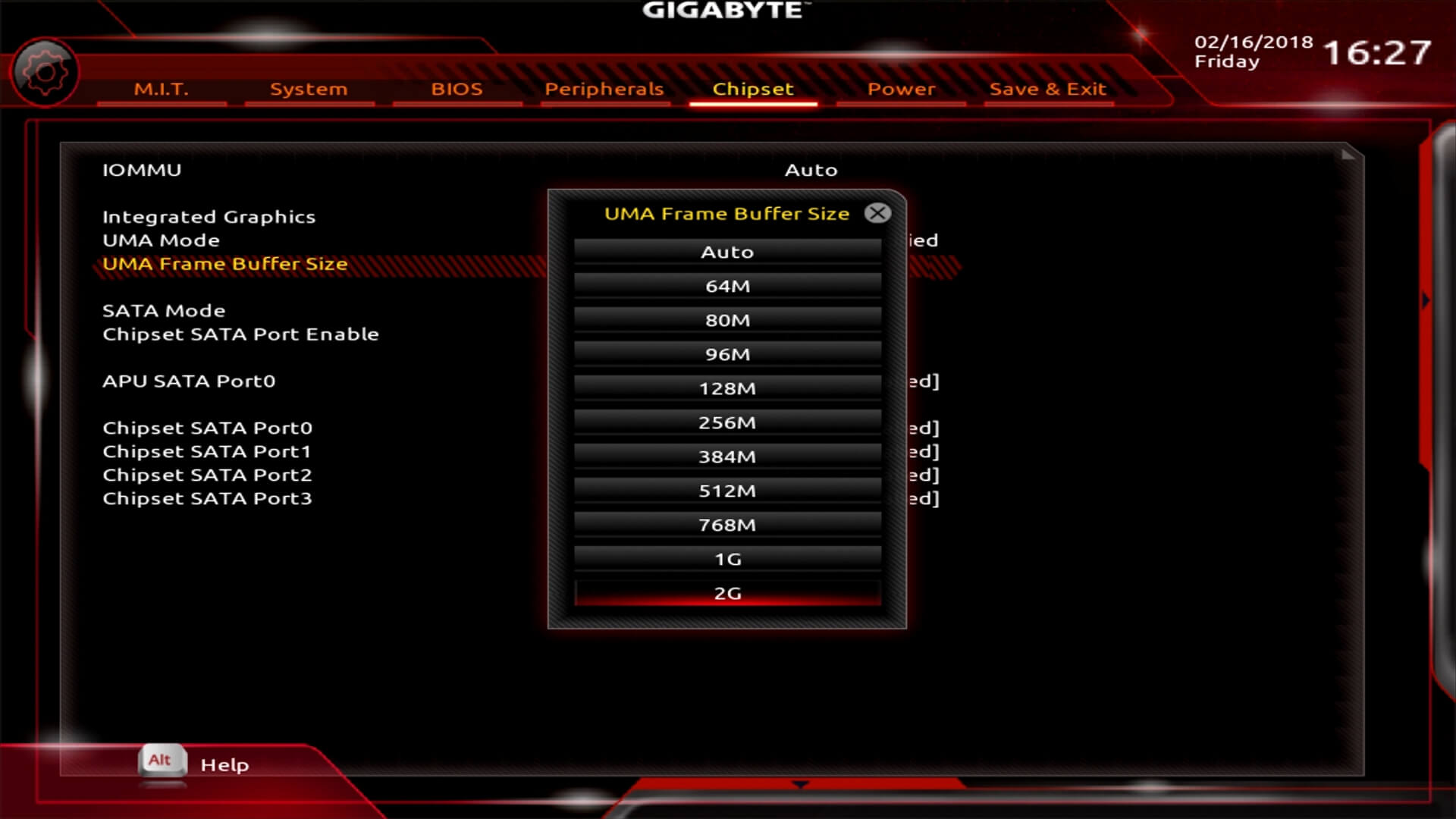
Now this is where I'm seeing a bit of confusion and misinformation. Some people are claiming that for best results reviewers should test with the frame buffer set to the maximum size and right now that's 2GB. However, this isn't necessarily true and as we're about to find out, most of you who have built or are planning to build a Raven Ridge system will want to do the complete opposite.
You are far better off selecting the absolute minimum amount of system memory that you can, because as I said, once you allocate a portion of your system memory to the graphics processor, that's all it can be used for.
If you go overboard here, then while running tasks that don't require much video memory in Windows you will have a significant chunk of idle memory that can't be used. If you were to select a 2GB buffer on a system that has 8GB of DDR4 memory, that would mean you'd only have 6GB of system memory available.
I wouldn't suggest choosing a 2GB buffer even if you wanted maximum performance in games. As I discussed earlier, when gaming, once the graphics memory or VRAM fills up, game assets are then loaded into system memory anyway and the Raven Ridge APUs using system memory exclusively, so regardless of whether you allocate 64MB or 2GB, it doesn't really matter.
If a game calls for 2GB of video memory but you've only allocated 64MB, usage still spills over into the shared RAM and because it's all the same memory the bandwidth remains the same and so does the performance. Windows manages this very well so by allocating 2GB you're just restricting the operating system's ability to manage system memory optimally.
When trying to make sense of why AMD was offering a 1GB and 2GB frame buffer, I initially thought that maybe by reserving a certain amount of memory, say 2GB, this would ensure maximum gaming performance as the operating system wouldn't have to shuffle things around, especially when using 8GB of RAM versus 16GB or more.
However, after testing various configurations I found this had little to no impact on gaming performance, certainly nothing you'd notice when gaming. Using both 8GB and 16GB of dual-channel DDR4-3200 memory with the exact same timings, I found no real performance difference between reserving 64MB or 2GB of system memory for example. I tested half a dozen modern titles that all call for around 2-3GB of VRAM at 1080p using low to medium quality settings.

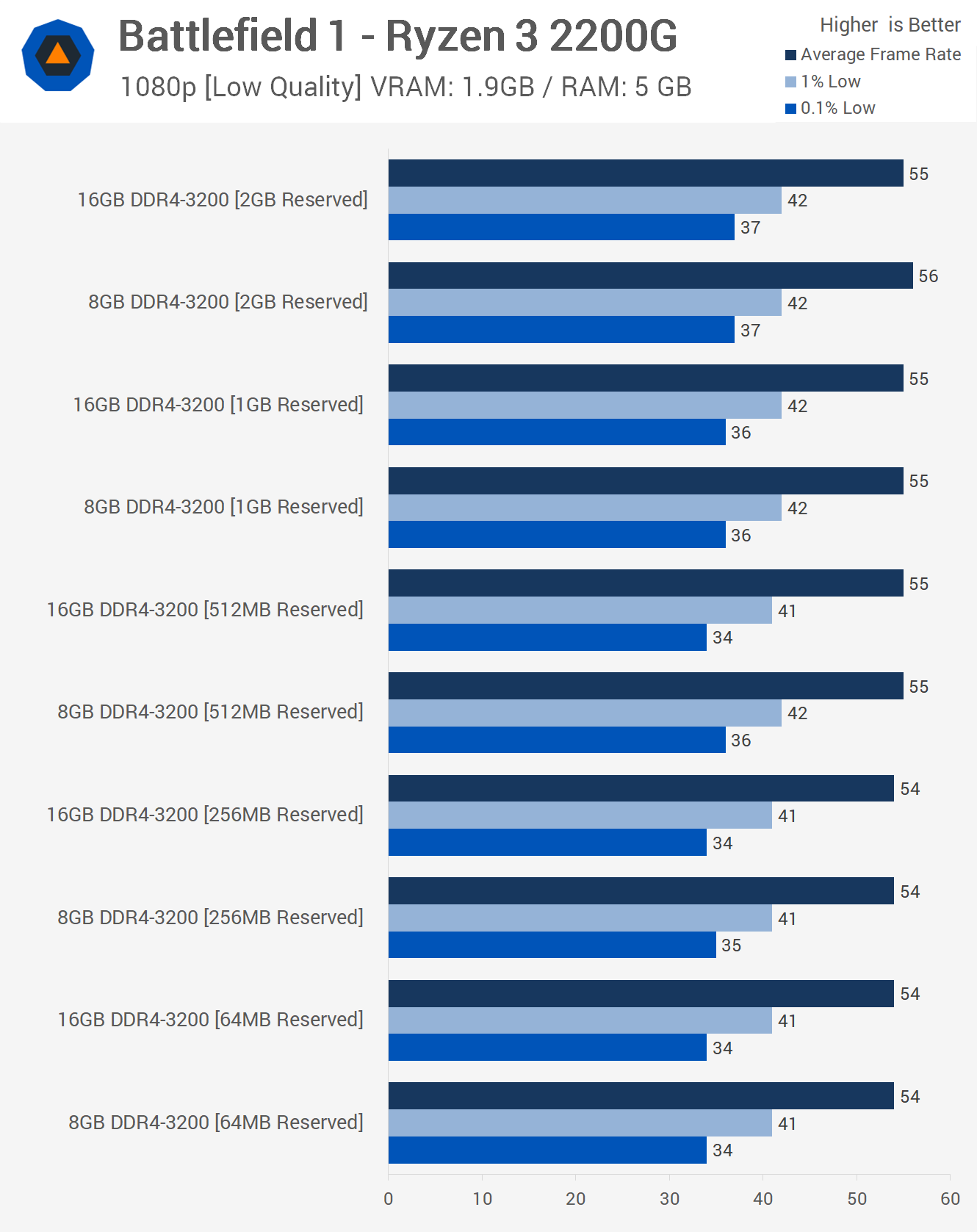
Rather than look at the half a dozen titles I've tested, all of which show the exact same thing, I'm just going to put up the Battlefield 1 results at 720p and 1080p, along with some additional testing with Metro: Last Light. As you can see with BF1, all the results are within the margin of error for a three run average and we're not just talking about the average frame rate but also frame time performance as well.
The 2GB configuration was up to 9% faster when comparing the 1% low results, but if we accept that there's a +/- 1fps margin of error here the difference could be as small as 3%. In any case it wasn't possible to spot this difference when actually playing the game and Battlefield 1 was one of the few games to show any kind of measurable difference.

I received a few reports that Metro: Last Light saw a massive performance uplift when going from 512MB to 2GB and although I stopped testing with this title about three years ago I thought it would be odd if true so I decided to check it out. This game uses very little memory and here we saw no difference in performance when comparing the average frame rate at 720p and 1080p, the same was true for the frame time results as well.
Given what we discussed previously before getting into the results, this really shouldn't surprise anyone. Regardless of whether the Vega GPU is accessing data via the allocated memory or not, if it's still using system memory and is limited to the same bandwidth, around 35GB/s in this case.

In fact, we can look at this a little more closely. Using the AIDA64 GPGPU benchmark tool we can measure read and write performance between the CPU and GPU, effectively measuring the performance the GPU could move data in and out of its own device memory into the system memory. This is also called Device-to-Host Bandwidth.
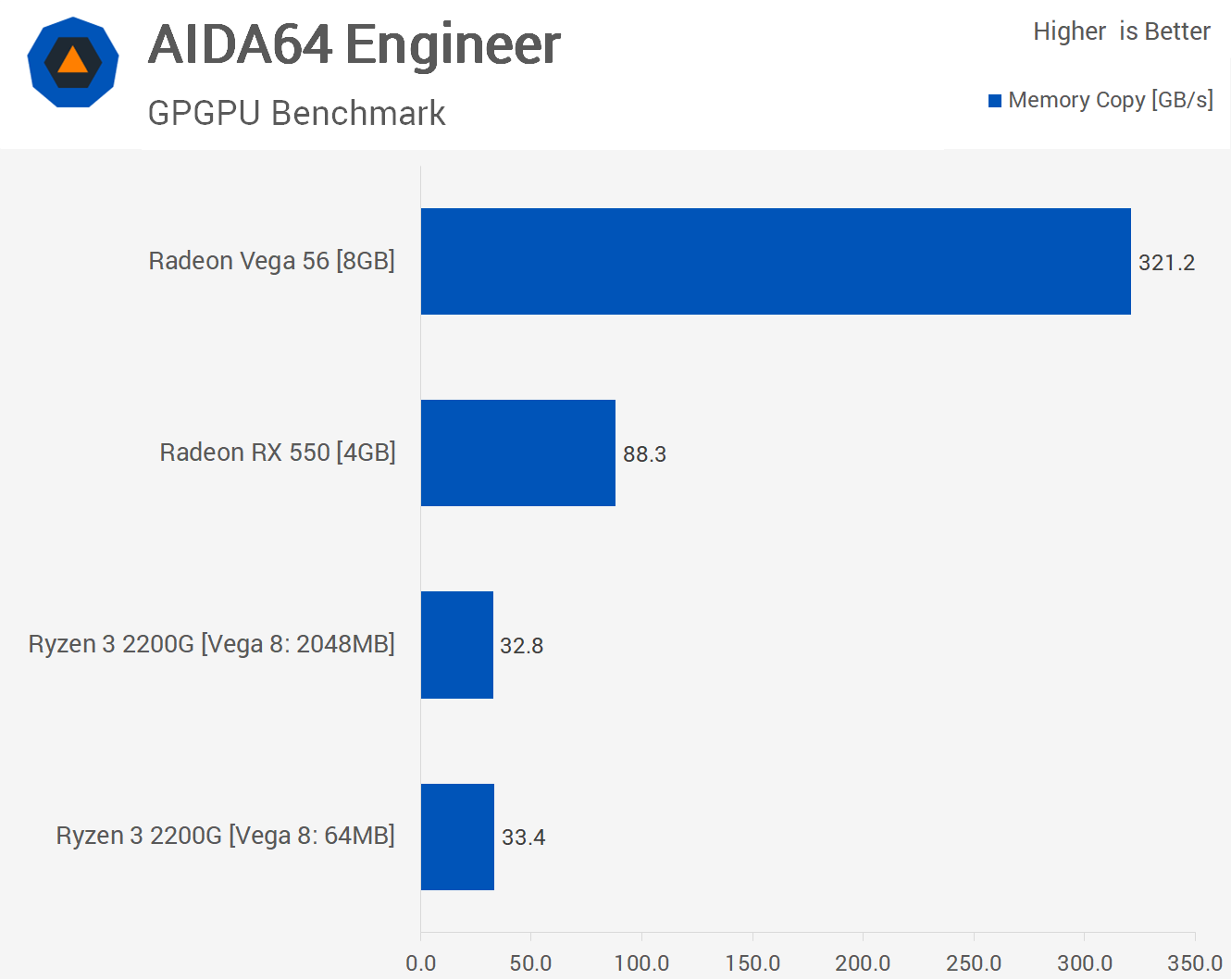
More importantly, for what I want to show, we can also look at memory copy performance. This test measures the performance of the GPU memory by copying data from its own device memory to another place within the same device memory. So in the case of the RX 550 that would be the onboard GDDR5 memory, but in the case of the Raven Ridge APUs, it's the system memory.
Here we can see that with 64MB of RAM allocated, the Vega 8 GPU in the 2200G has a throughput of 33.4GB/s when copying data from within the system memory, and that's pretty much in line with the 35GB/s the CPU cores have when accessing the DDR4-3200 memory.
If we increase the allocation size to 2GB, this has no impact on bandwidth and instead based on an average of three runs we saw a slight decrease but that is within the margin of error. Given how long this test takes it's safe to assume we are transferring well over 2GB of data so it's not just benchmarking within the allocated buffer. Then if we look at the RX 550 which has a theoretical peak bandwidth of 112GB/s we see in this test it was good for 88GB/s. For comparison, I benched a Vega 56 and this model hit 321GB/s with a theoretical peak bandwidth of 410GB/s.
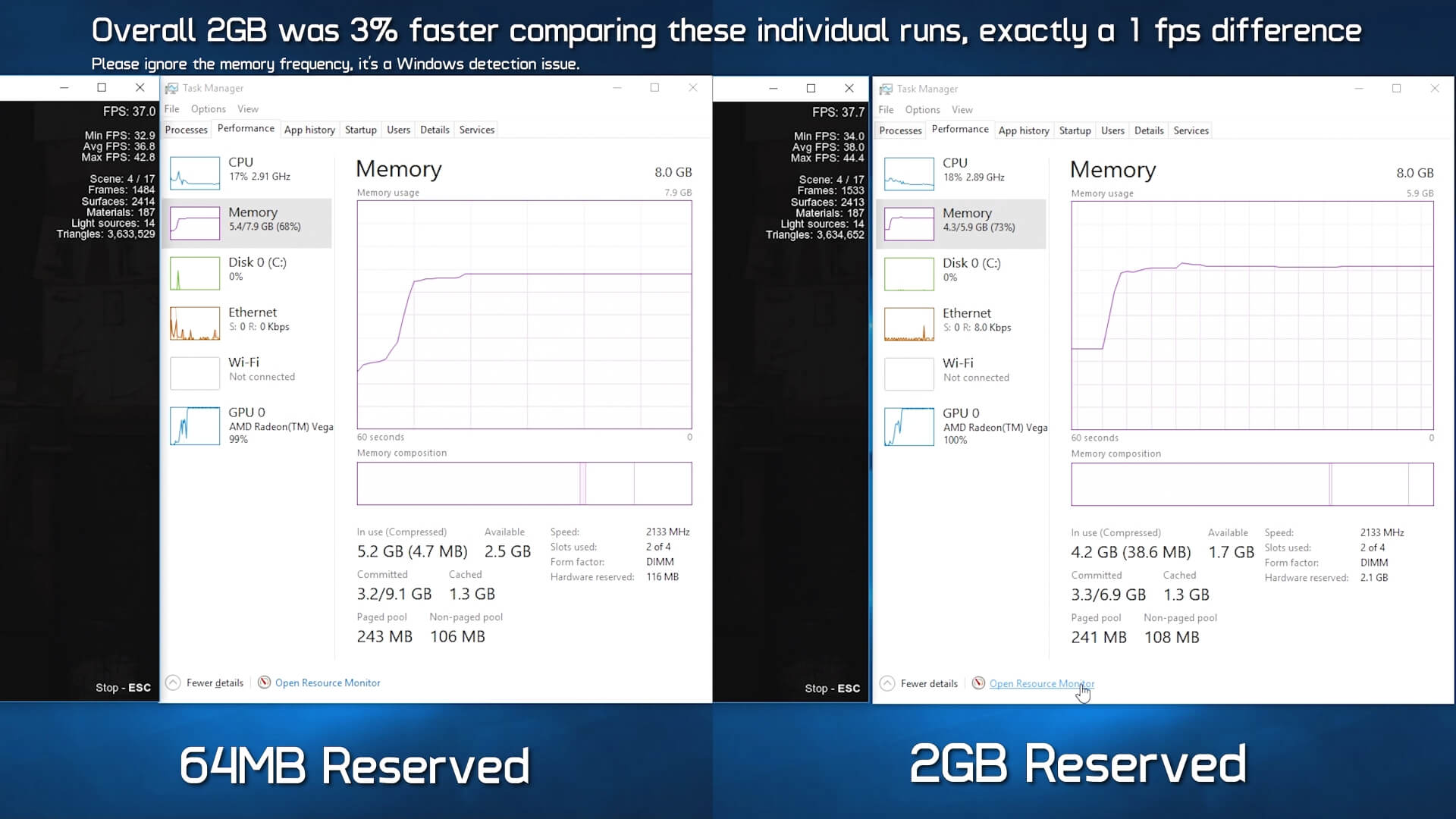
So all the evidence suggests that setting the iGPU allocated memory buffer beyond 64MB is pointless and on systems with limited RAM, even a bit foolish. That said, while I've tested quite a few games and applications now, I haven't test them all and of course I won't be able to as there simply aren't enough hours in the day.
The only reason I can see why you might want to increase the reserved memory buffer is for games that need to detect a certain amount of VRAM before they will load. We've seen games with built in safeguards that won't allow you to load them without meeting a minimum hardware spec. It's annoying as the game developer isn't saving anyone from anything, certainly no real harm, instead they're just inconveniencing gamers that probably have acceptable hardware but are waiting on a driver update to improve detection.
I expect that AMD will always deliver drivers to solve these kinds of issues for new games if and when they arise, but we might see situations where in the meantime gamers can increase the allocation to meet the VRAM requirements, allowing them to load into the game. So short of potential compatibility issues, I can't think of any reasons why you'd want to sacrifice more than 64MB of memory to the GPU, but maybe you guys have some ideas.
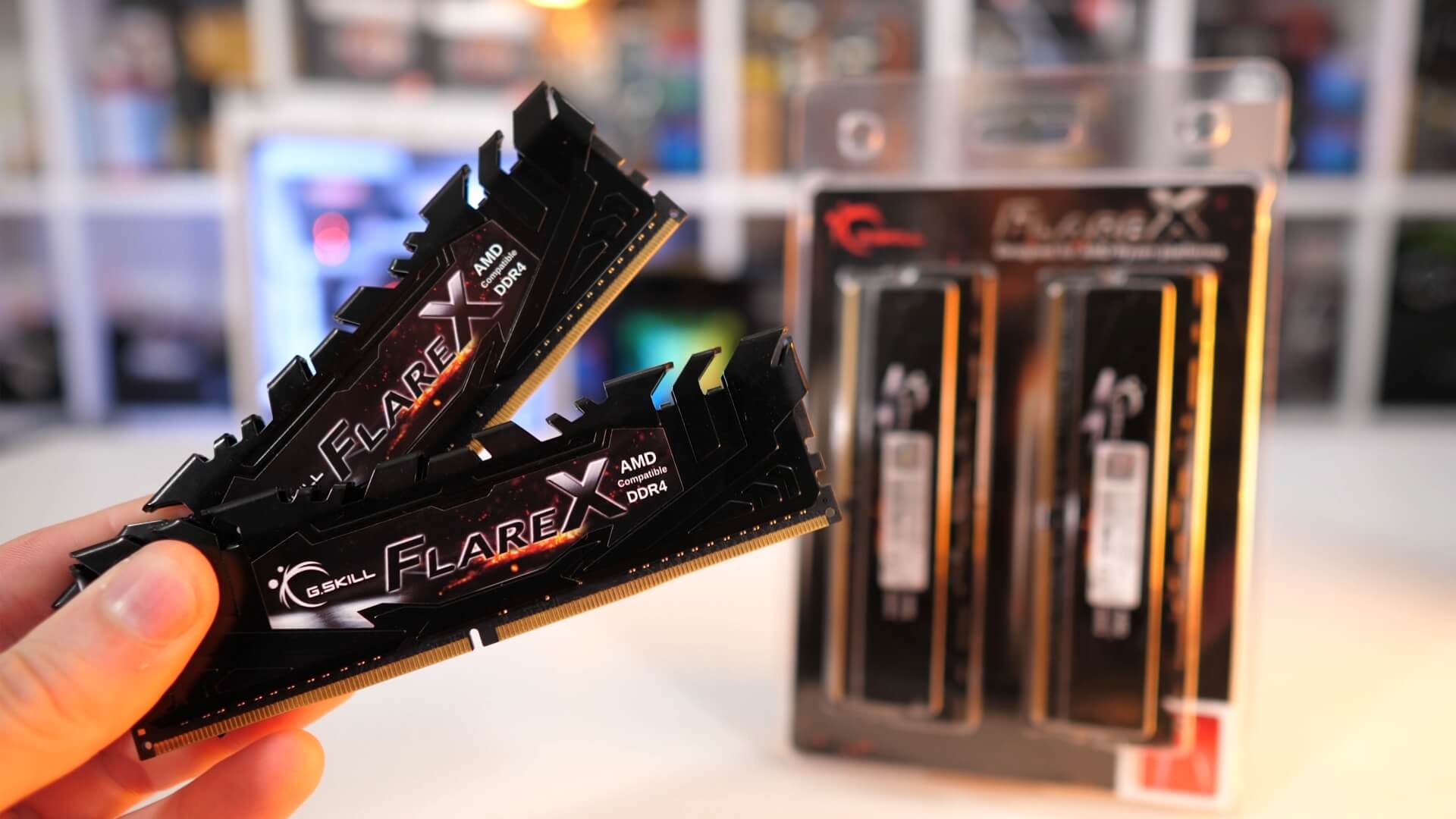
Please also note that 64MB might be an extreme example, maybe err on the safe side and set it to 512MB. Or you could just go with 64MB and wait till you run into an issue and if you do please let us know about it. At that point, you would only have to reboot the system, increase the allocation and then load back into Windows.
Since most APU users will be using two 4GB memory modules for an 8GB capacity, especially those buying the incredibly good value Ryzen 3 2200G for $100, those users will want to save as much memory as possible and telling them to lop off 1-2GB for the Vega GPU seems like really bad advice based on my findings.
Circling back to the time when I was talking about trying to make sense of why AMD was offering up a 2GB frame buffer, there's even been talk that AMD is pushing board partners to offer a 4GB option. But why, AMD? Why give your customers the ability to degrade their experience on your impressive Raven Ridge APUs?
Well, the reason is simple, marketing. AMD has to play the game of numbers. Saying 2GB or up to 2GB of graphics memory sounds better than 64MB. That said, AMD doesn't appear at this stage to be advertising Vega 8 and Vega 11's memory spec. Maybe this will start to pop up once the company nears the launch of 4GB allocation.
As we were putting final touches on this feature and our testing, we got in touch with AMD and after giving them our results they're having their engineers looking into it. AMD tells us they are testing a wide range of games and we have also tested beyond what you see here.
For the most part we saw very little difference. At most, averages vary by up to 5% in some instances but it's mostly 3% or less. You may gain an extra 2-3 fps using 2GB opposed to 64MB in the best case scenario, but Raven Ridge is way more appealing on the low end if I can have almost all 8GB of my system memory when using applications in Windows, rather than only 6GB.
So for users with 8GB or less RAM you're better off with the 64 - 512MB options. Just apply a small overclock to gain a few extra frames when you need them.
-
มนุษย์รักเดียวใจเดียวโดยธรรมชาติจริงหรือ นิสัยไม่เจ้าชู้ดีต่อวิวัฒนาการหรือไม่ ?纸嫁衣2第四章图文攻略Xbox Ally X IGN上手心得:终于迎来最理想的游戏掌机搜打撤新游《逃离鸭科夫》亮相苹果开发者大会 Steam试玩已开启Back to School Tech Guide 2018莆田特色小吃干炸荔枝肉 干炸外酥里嫩块块香迷室往逝攻略大全 迷室往逝通关图文攻略汇总รพ.ตร.สั่งตั้งกรรมการสอบวินัยร้ายแรง万能沙雕评论美女语录 适合用来夸美女的语录喜报!联运智慧环卫项目再获业主单位表扬
下一篇:《剑星》PC版实机演示 女主穿红旗袍露大白腿
- ·奋力书写“暖心答卷”,让老年人生活有助,安全有护,健康有保障
- ·太原好马汽车技术发展有限公司
- ·提升公共空间品质,深圳金属垃圾桶助你一臂之力
- ·Apple's new iOS 26 makes live translation seamless
- ·怪物乐土格鲁鲁获取方法介绍说明
- ·吞食天地2重制版阵形效果是什么
- ·人生最值得看的十本书 2025最治愈的书籍分享
- ·纸嫁衣2第四章图文攻略
- ·《我的情人在草原》(格格演唱)的文本歌词及LRC歌词
- ·Crypto Markets Shed Over $100 Billion After Trump's Latest Tariff Threats (Weekend Watch)
- ·杭州市余杭区智慧环卫监管平台正式投入运行
- ·A galaxy from 11 billion years ago just reappeared in a shocking way
- ·The Path to Season 02: DMZ Update
- ·中马协举办青少年马术体能线上课
- ·生活要随心的说说短句 生活就是这样随心说说
- ·These Are This Week's Biggest Altcoin Gainers and Losers as BTC Slides to $108K (Weekend Watch)
- ·哈兰超人再次归来 《消逝的光芒:困兽》发布30分钟实机演示
- ·Tiny nuclear battery could power devices for decades
- ·生活要随心的说说短句 生活就是这样随心说说
- ·太原好马汽车技术发展有限公司
- ·Switch 2成美国发售4天最畅销游戏机 或已超100万
- ·莆田特色小吃干炸荔枝肉 干炸外酥里嫩块块香
- ·国产科幻机甲游戏《解限机》定档7月2日公测,登顶Steam国产游戏愿望单榜首
- ·为什么《生化危机9》没有萝丝?舅舅:她当时只有5岁
- ·教孩子写作业气到爆的朋友圈文案 辅导孩子写作业的心情短句
- ·李蓓称股市现为20年一遇机会 百亿私募连续两周加仓
- ·Champions Cup future in jeopardy
- ·浙江新宏基真空电器有限公司太原办事处
- ·《无光之海》开发商新作《Mandrake》公布
- ·快手aauto quicker常见问题及如何解决
- ·6 โมงเย็น ฝนยังตกที่บางขุนเทียน ทุ่งครุ จตุจักร วังทองหลาง ดินแดง ห้วยขวาง พระนครตอนล่าง
- ·李蓓称股市现为20年一遇机会 百亿私募连续两周加仓
- ·Crypto Markets Shed Over $100 Billion After Trump's Latest Tariff Threats (Weekend Watch)
- ·6月3日油价调整最新消息:92号和95号汽油价格是涨是跌预测
- ·Australia vs. Japan 2025 livestream: Watch World Cup qualifiers for free
- ·马术一星级专业教练培训考核5月开展

